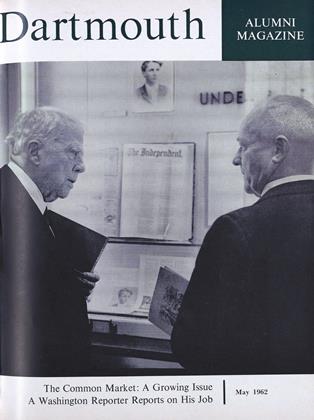By Alexander Laing '25. NewYork: E. P. Dutton, 1961. 346 pp. $15.00.
Practicality and boldness were the qualities that made America; and they are nowhere to be seen more clearly than in the story of American sail. One can discern in William Phips., shepherd boy who became apprentice to a ship's carpenter and eventually Governor of the Province of Massachusetts Bay, that combination of daring, selfconfidence, and practical planning which made him hero of the search for sunken Spanish silver and which later enabled him to halt the witchcraft folly at Salem. Both the ships and the men of the new nation show the lines of the emerging American character.
Hemmed in by the superior power of British and French sail, and restricted by their trade monopolies, the Americans responded with inventiveness and determination. Speed and weatherliness were made to do against sheer force, and they did very well.
American Sail: A Pictorial History is to be highly recommended for many reasons. The pictures alone will give enduring pleasure. But they were chosen not merely to delight. They show, from a "contemporaneous view," what it meant to live in the formative era of America, the age of sail. The text does far more than explain the technical changes of sail and ship design. It contains a series of pointed biographies, some of well-known heroes such as John Paul Jones or Benjamin Franklin, others of men previously unknown to me but well worth meeting - William Phips, Adolphus Conyngham and Joshua Slocum. Attention is given to both naval and commercial developments, to the romantic China trade and whaling, and also to the brutalities of the slave trade.
Though the development of the steam and marine engines brought an end to the of commercial sail, the tradition is carera, on by the amateur yachtsman. The "mall craft, on its own, is not just a vehicle of escape Rather it brings men to face reality in situations where their independence of judgment and ingenuity is tested. The remarkable career of Joshua Slocum, professional turned amateur," indicates that, though conditions may change, American sail has not only a colorful past but an appealing future.
As befits an author who is himself skilled in the ways of the sea, American Sail combines the virtues of beauty and utility. It delights the eye, and it teaches American history as no dull textbook ever did.
 View Full Issue
View Full Issue
More From This Issue
-
 Feature
FeatureCOMMON MARKET
May 1962 By WALDO CHAMBERLIN -
 Feature
FeatureA Reporter in Washington
May 1962 By ERNEST L. BARCELLA '34 -
 Feature
FeatureSGT. BROWN'S RUGGED BOYS
May 1962 By CLIFF JORDAN '45 -
 Feature
FeatureThe Dictionary's Function
May 1962 By PHILIP B. GOVE '22 -
 Feature
FeatureDartmouth in the Public Service
May 1962 -
 Feature
FeatureMUSIC ADVISORY GROUP TO AID HOPKINS CENTER
May 1962
FRED BERTHOLD '45
Books
-
 Books
BooksComplex Occurrences
DEC. 1977 By F. David Roberts -
 Books
BooksINTERNATIONAL SHIPPING CARTELS.
June 1953 By J. S. Ransmeier -
 Books
BooksHESIOD: THE WORKS AND DAYS, THE-OGONY, THE SHIELD OF HERAKLES.
January 1960 By JOHN B. STEARNS '16 -
 Books
BooksALL THE BEST IN HAWAII
January 1950 By Mildred L. Saunders -
 Books
BooksCOMPARATIVE ANATOMY AND EMBRYOLOGY.
JANUARY 1965 By THOMAS B. ROOS -
 Books
BooksELEAZAR WHEELOCK: FOUNDER OF DARTMOUTH COLLEGE,
October 1939 By Wayne E. Stevens





